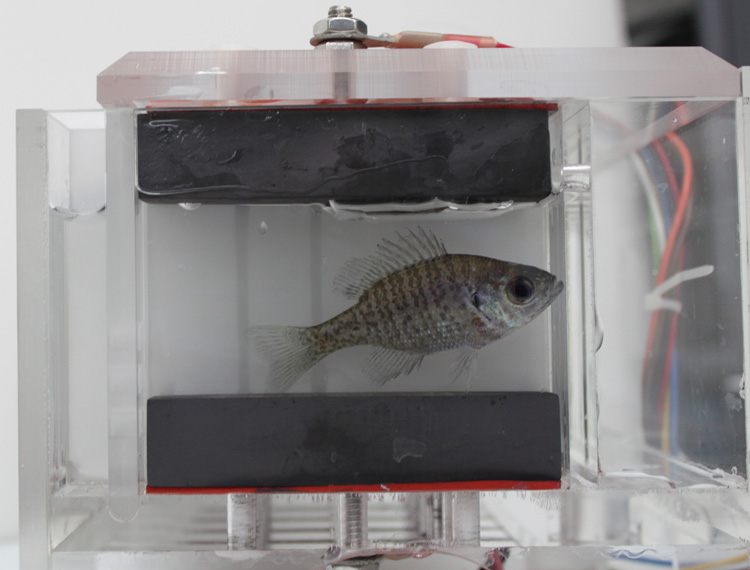USACEHR Employs Fish to Monitor Water Supplies

One Army-developed technology relies on nothing more than Mother Nature to help ensure that a daily and vital substance is safe and readily available. The aquatic biomonitor (available commercially as the Intelligent Aquatic Biomonitor System or iABS) uses fish and their breathing patterns to detect the presence of potentially toxic substances in water. The iABS employs a team of eight bluegill (Lepomis macrochirus), also known as sunfish or bream, to provide 24/7 monitoring of water supplies.
The United States Army's Center for Environmental Health Research is tasked with developing biomonitoring technologies for the many environmental health hazards that our Military members face on a day-to-day basis. Biomonitoring assesses exposure to and presence of different chemicals, natural or synthetic, in a given environment. The information collected by USACEHR enables them to provide diagnostic and prognostic tools to the Military for environmental and occupational health surveillance.
The eight fish are deployed for a three week tour of duty, while eight others wait on standby to be rotated in. The fish are placed into individual "stalls" separated by a frosted glass pane. Carbon block electrodes are suspended above and below each fish which captures the electrical signals generated by the muscles in the fish as they breathe (similar to heart rate patterns on an EKG). The device monitors ventilation rate, average depth of signal, cough rate and percent movement, as well as water quality parameters, such as water pH, temperature, conductivity, and dissolved oxygen, which are known to affect the way a fish breathes. To protect these eight worker fish, the device is also designed to withstand any non-toxic events, such as power or water flow failure.
All of the collected data are then converted to electrical signals which are amplified, filtered, and transmitted to a laptop computer where they can be analyzed for changes in the environment. If six of the eight fish start behaving abnormally the device sends out an alert and begins an automated sampling process to screen the water more thoroughly for toxins. If a toxic threat is determined to be present, personnel are then called in to mitigate the issue.
The iABS is designed to be rugged and completely self contained. Additionally, it can be set-up to provide usable data in a relatively short amount of time. Laboratory tests have shown that the iABS responds within an hour to most chemicals at acutely toxic levels. Within a few hours the iABS can produce real-time monitoring using nothing more than fish, the existing water supply, and electricity. Furthermore, the electronic components used in the device are relatively low-cost and the automated biomonitor only alerts personnel as needed, so there is no need for continuous observation. The design of the iABS helps to keep costs down and the technology sustainable.
This novel combination of science and nature was transitioned to commercial development by a team of USACEHR scientists with support from an Army Science and Technology Objective. The Environmental Sentinel Biomonitor Team was lead by USACEHR Science & Technology Director, Dr. William van der Schalie and team of researchers and biologists. In December 2004, the iABS was awarded an Army Research and Development Award and in June of 2010 Dr. van der Schalie and the team were Service to America Medals Award Finalists as a result of their work in aquatic biomonitoring. Tommy Shedd, a research biologist who worked on the iABS says, "Fish are one of the greatest model systems for the detection of contaminants in water; when you think of the potential for human chemical exposure from water, what better indicator of the potential hazard than a living organism like the fish. The fish are a first line of defense as broadband detector of potential harmful chemical hazards in water because of their integrated rapid response to abnormal contaminants in the water. The fish do not tell you what the problem is, just that there is a water problem that you should investigate further. Currently, this technology is being applied at Fort Detrick and several major municipality water treatment facilities as a continuous real-time monitor for the intentional or unintentional addition of chemical contaminants in source and/or potable drinking water."
The iABS is currently being used in several large municipalities across the United States to monitor water supplies. The eight small fish that are a part of this device could potentially save millions of people from using contaminated water sources. In one large city, the bluegills detected a diesel fuel spill in the water source before it reached the water supply. The USACEHR is also looking into other potential tools that employ this same type of technology. One technology uses cell monolayers to detect toxicity; changes in electrical resistance across the cell layer signal a change in the environment. This allows for a smaller and more transportable device that could be used in the field or combat to ensure that water is safe and free of contaminants.
---
The views, opinions, and/or findings contained in this report are those of the author(s) and should not be construed as official Department of the Army position, policy, or decision, unless so designated by other official documentation. Citations of commercial organizations or trade names in this report do not constitute an official Department of the Army endorsement or approval of the products or services of these organizations. Research was conducted in compliance with the Animal Welfare Act, and other Federal statutes and regulations relating to animals and experiments involving animals and adheres to principles stated in the Guide for the Care and Use of Laboratory Animals (NRC 1996) in facilities that are fully accredited by the Association for the Assessment and Accreditation of Laboratory Animal Care, International.














